|
You've
just got to love a city that erects a bronze
statue of a local gay magistrate accused of
too closely examining the nether regions of
three male suspects. On a bronze frieze, at
the base of the Alexander Wood statue on the
corner of Church and Alexander in Toronto,
the deliciously scandalous scene from the
dawn of the nineteenth century is recreated
for your delectation.
Such attention to personal detail took a
heavy toll on Wood, one of Toronto's
founding fathers, with the resultant sodomy
charges branding him with the epithet
"Molly" and sending "Molly" Wood back to
Scotland.
And yet, arguably, Wood prevailed - for it
was his fifty acres of land that became
known as "Molly Wood's Bush," and that
"bush" is now Church Wellesley, known the
world over as Toronto's Gay Village. Apart
from the statue, erected in 2005,
acknowledging Alexander Wood as a forefather
of Toronto's gay community, there is both an
Alexander and a Wood Street in the Village.
Not long after our viewing of Alexander Wood
in all his majestically caped glory, we met
an ebullient FTM Toronto transsexual who
spoke to us about returning to his small
town in Scotland. He was there for a family
reunion, with more than a hundred extended
family members gathered around him - and
yet, as he shared with us, it was in
returning to Toronto that he felt most at
home, surrounded by those he regarded as his
unconditionally loving family.
There's something in both of these anecdotes
that captures the spirit of Toronto:
something about the city's inclusiveness and
its colorful characters. With over 200
ethnic groups represented in its population,
Toronto (which is the fifth most populous
city in North America) has a citizenry that
speaks more than 130 languages and dialects,
a fact that becomes understandable when you
consider that more than fifty percent of
Toronto's populace was born outside Canada.
In all the world's cities, only Miami,
Florida has a higher percentage of
foreign-born citizens.
Arguably, some of Toronto's early
inclusiveness can be traced to slavery,
which was banned in Upper Canada in 1834 -
and which enabled escaped African-Americans
to settle in the city then known as York.
The city's spirit of inclusion took somewhat
longer to reach its LGBT population; for
years, gay men were attacked by homophobes,
particularly on Halloween at one of the
subculture's underground bars. Similar to
Stonewall in New York, there came a point
when enough was enough - and in 1981, after
the mass arrest of more than 300 gay men,
Toronto's LGBT movement achieved momentum,
thereafter evolving into Toronto's Gay Pride
Week, which has become one of the largest
pride celebrations in the world.
Today, Church Wellesley, the Gay Village, is
anchored by the 519 Church Street Community
Center in a beautifully-refurbished building
that once housed the Granite Club, one of
Toronto's more prominent and private
gentlemen's clubs - and how fitting it is
that the building now belongs to the LGBT
community. There it is: the entire evolution
of Toronto's inclusiveness revealed in one
building's history.
One of every four Canadians live in Toronto.
It's no wonder there are more than 7,000
restaurants.
Colorful at Every Corner
Toronto became the largest alcohol
distillation (in particular spirits) centre
in North America, the Gooderham and Worts
Distillery operations became the world's
largest whiskey factory by the 1860s.
no single nationality or culture dominates
Toronto's immigrant population, placing it
among the most diverse cities in the
world.[71] By 2031, Toronto's current
visible minority population will have
increased to 63%, changing the definition of
visible minority in the city.[77] More than
100,000 immigrants arrive in the Toronto
area every year.[78]
is the provincial capital of Ontario, and
the largest city in Canada. It is located in
Southern Ontario on the northwestern shore
of Lake Ontario.
As Canada's economic capital, Toronto is
considered an alpha world city by the
Globalization and World Cities (GaWC) study
group[6] and is one of the top financial
centres in the world.[7][8] Toronto's
leading economic sectors include finance,
business services, telecommunications,
aerospace, transportation, media, arts,
film, television production, publishing,
software production, medical research,
education, tourism and sports
industries.[9][10] The Toronto Stock
Exchange, the world's eighth largest in
terms of market value, is headquartered in
the city, along with the most Canadian
corporate headquarters of a major Canadian
city.
Toronto is consistently rated as one of the
world's most livable cities by the Economist
Intelligence Unit[14] and the Mercer Quality
of Living Survey.[15] In addition, Toronto
was ranked as the most expensive Canadian
city in which to live in 2006
While the neighbourhood is home to the
community centre, parks, bars, restaurants,
and stores catering to the LGBT community
(particularly along Church Street), it is
also a historic community with Victorian
houses and apartments dating back to the
late 19th and early 20th century. Many LGBT
people also live in the nearby residential
neighbourhoods of The Annex, Cabbagetown,
St. James Town, St. Lawrence, Riverdale and
the Garden District, and in smaller numbers
throughout the city and its suburbs.
Church and Wellesley is also home to the
AIDS Memorial, located in Cawthra Park,
where the names of members of the community
who have been lost to AIDS are etched into
bronze plaques. A memorial candlelight vigil
is held each year at the AIDS Memorial,
during Pride Week.
Church Street and the area around it has
been familiar to the Toronto gay community
for many decades. Prior to the 1970s there
had been an underground (mostly male) gay
scene centred around various bathhouses and
bars around the city that were not
exclusively gay establishments but were
known to be frequented by homosexuals. Allan
Gardens, just east of Church Street on
Carlton, was a well-known cruising area for
gay men.
In the 1980s, the 519 Church Street
Community Centre became the meeting place
for numerous social and political groups and
became well known as an LGBT friendly space.
WHAT TO SEE:
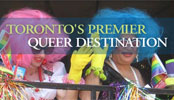
Church Wellesley: There's something
metaphoric about the fact Church Wellesley
is located in the heart of Toronto.
Something apt and right, given the Gay
Village's reputation for inclusiveness and
openness. Ever since the 1981 bathhouse
raids, which served as a wake-up call for
Toronto's LGBT population, Church Wellesley
has been an ever-evolving neighborhood,
increasingly filled with bars, shops,
boutiques, theatres, and restaurants.
One of the best ways to discover the roots
behind this vibrant community is to take a
tour with someone like Liz Devine. A
long-term resident of Church Wellesley,
Devine's love for her neighborhood is
matched by her commitment to LGBT equality.
To walk Church Wellesley with someone so
well-known is to witness firsthand the
intense connection that Torontonians have to
their city and their gay village - and to
hear Devine speak about the neighborhood's
evolution is a lesson in gay history. We
didn't just arrive here, kids: there were
pioneers who fought for us.
LINK:
http://www.churchwellesleyvillage.ca/
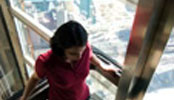
CN Tower: Though it's not listed on the
lighting schedule, we could swear that we
saw the most iconic structure on Toronto's
skyline glowing lavender at night. Perhaps
it was the reflected light of so many LGBT
people in town, but regardless of what it
was, after seeing that lavender light, how
could we not shoot to the top in a
glass-bottomed elevator (introduced in 2008)
that traverses the tower's 112 stories in a
mere 58 seconds?
Opened in 1976, the CN Tower is still the
Western Hemisphere's tallest "tower," which
is Guiness' Book of World Records' way of
fudging the impact of other skyscrapers the
world over. More than 2 million visitors
take the 15 mph elevator to the top
annually. Check your vertigo at the elevator
exit - and step out onto the glass floor.
There, below you, is terra firma - and
you're high atop the needle feeling like
Philip Petit or Jack on the Beanstalk (or
else you're hysterical and cowering near the
wall. It happens.)
If you need something to calm your nerves,
have a cocktail at 360 Restaurant - and
watch as the world turns at your feet, a
complete revolution every 72 minutes. On
second thought, make it a double - and
double your fun on the elevator back to
earth.
LINK:
http://www.cntower.ca/
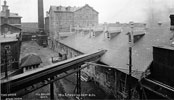
Distillery District: A National Historic
site, the Distillery District contains some
of the best examples of Victorian Industrial
architecture on the continent - now
converted into a pedestrian-friendly
neighborhood not unlike SoHo or the
Meatpacking District in New York, where the
nineteenth century is evidenced in stone and
brick buildings, repurposed timber and
planks, all utilized in a creative fusion of
21st-century design with 19th-century
materials. The Distillery District oppened
in 2003 and has subsequently become an
anchor of Toronto's booming art scene, with
a plethora of galleries, shops, studios, and
boutiques. For chocaholics, Soma Chocolate
is mandatory - and specifically, their
well-loved Mayan Hot Chocolate spiced with
chili. In a word: heaven.
LINK:
http://www.thedistillerydistrict.com/
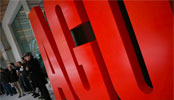
Art Gallery of Toronto (AGO): Local boy
Frank Gehry's reimagining of one of
Toronto's premier museums has turned the Art
Gallery of Ontario (AGO) into an
architectural wonder whose primary joys are
actually on the interior (not always the
case with architectural statements). The
three-year Gehry transformation expanded the
AGO (founded in 1900) by more than 75,000
feet - and the resultant citywide vistas
from numerous viewing platforms are a
valentine to Toronto.
Currently occupying the entire fifth floor,
Julian Schnabel: Art and Film runs through 2
January 2011 - and this galvanizing
retrospective alone is worth a flight to
Toronto. If you remember Schnabel from the
Eighties and you thought you knew him,
pigeonholing him to his pottery paintings,
then this exhibition will be epiphanic as
you reconsider the breadth and depth of
Schnabel's passion as a painter as conveyed
through his love for film. An award-winning
filmmaker, Schnabel proves himself a titan
of both mediums.
LINK:
http://www.ago.net/
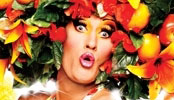
Priscilla, Queen of the Desert: In case you
have yet to hear, this is the gayest show on
the planet. If you thought the 1994 film was
queer heaven, then you'll be in paradise
with this 320-costume extravaganza that's an
amalgam of Busby Berkeley and every bar
mitzvah and circuit party you've ever
attended, along with a healthy dose of San
Francisco's long-running, big-hat
spectacular "Beach Blanket Babylon." With a
high-energy, high-kicking cast, headed by
the multi-talented heartthrob Nick Adams
(Tony award, we're betting on it...),
"Priscilla" is a confetti-shooting cavalcade
of disco's greatest hits, performed with
heart and humor (and just a spoonful of
sugar), wrapped in a sweetly empowering tale
of following your fabulous dreams to the end
of the rainbow. Warning: resistance is
futile; "Priscilla" will dismantle your
disdain - and send you home a disco queen.
Now playing at the Princess of Wales Theatre
(named for Lady Di - and don't you know she
would be dancing in the aisles...) through
December 2010. Tip: take a trip to Toronto
and see this indefatigable show before it
conquers Broadway and becomes a New York
City sensation.
LINK:
http://www.priscillathemusical.com/
http://www.mirvish.com/shows/Priscillaqueenofthedesertthemusical
WHERE TO STAY:
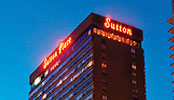
Sutton Place Hotel: If you've found yourself
wearying of the West Elm/Philippe Starck
design sensibility that's conquered boutique
hotels around the globe, then you'll
appreciate the Old World charms of the
Sutton Place Hotel. Perfectly situated a
block away from the intersection of Church
Wellesley (aka the Gay Village), the Sutton
Place Hotel's Modernist exterior belies its
European interiors. Walking through the
marbled lobby and the carpeted hallways and
entering into a room furnished completely in
French Provincial might have you feeling as
you're visiting your godmother: the wealthy
one who's always slipping you a fifty every
time you brunch with her. Breakfast with her
in Accents Restaurant, below the photograph
of Liza: the Sutton Place Hotel is where
Liza stayed when she was in town performing
- back in the Sixties. Built in 1967 (and
renovated in 1998), the Sutton Place Hotel
retains all of the high design standards of
both periods - chandeliers, Chippendale
breakfronts, and chintz - and it's a
delicious time warp to be in residence here.
LINK:
http://www.toronto.suttonplace.com/default.htm
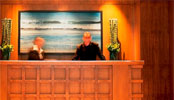
Hotel Le Germain: Located an easy stroll
from the CN Tower and the Princess of Wales
Theatre, Hotel Le Germain Toronto is a
sanctuary of modernism with two-story glass
walls and a double-sided fireplace in the
lobby. As with the other hotels in Groupe
Germain's family (located in Calgary, Quebec
City, and Montreal), Hotel Le Germain
Toronto's focus on elegant style (Egyptian
cotton linens, goose-down duvets, feather
pillows) and personalized service (for your
canine, too) make it difficult to leave.
Germain Groupe's second Toronto hotel, Hotel
Le Germain Maple Leaf Square, opens in
November 2010 in a 167-room, glass-and-metal
structure with guest rooms ranging in size
from 400 to 1,500 square feet. With Frette
linens, 40-inch HDTV, and complimentary WiFi,
Hotel Le Germain Maple Leaf Square is going
to make is just as difficult to leave these
rooms. Give in to the Germain difference -
and soak up Toronto's charms.
LINK:
http://www.germaintoronto.com/en/home
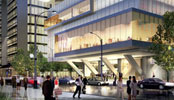
The Ritz-Carlton Toronto: Recently, we had
the pleasure of attending a launch luncheon
highlighting the culinary skills of Chef Tom
Brodi, the man in the kitchen of the
about-to-be-opened TOCA at the new
Ritz-Carlton Toronto - and if Brodi's
sublime cooking is emblematic of this
five-star hotel, then Torontonians are about
to witness the arrival of the city's most
luxurious and lavish destination.
Scheduled to open on the 1st of February,
2011, the Ritz-Carlton Toronto soars 53
stories into the sky, with 267 rooms and 159
condominum residences, all located in the
heart of the newly-shimmering Entertainment
District.
(Did we mention the 23,000-square-foot spa?)
LINK:
http://www.ritzcarlton.com/en/Properties/Toronto/Default.htm
WHERE TO EAT:
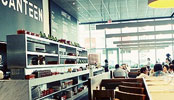
O&B Canteen: Already a hit - and it's only
been open since September 2010. But then
Oliver & Bonancini, the company behind O+B
Canteen, has been a significant player in
the Toronto culinary scene since the opening
in 1993 of Bay's Street's Jump. Partners in
the Distillery District's Soma Chocolate
(swoon), as well as numerous other excellent
eateries around town, Oliver & Bonancini
have helped shape the re-emergence of
Toronto as a fine dining destination.
O&B Canteen, at the base of the TIFF Bell
Lightbox (the brand-new, gorgeous home of
the Toronto Film Festival), is the more
casual eatery in the O&B empire. With a menu
that emphasizes fresh market ingredients and
artisanal baked goods, O&B Canteen
percolates with energy from morning through
night. One of the more cheerful and polished
staffs in town (as well as reasonable
prices) help make O&B Canteen a perfect
post-theatre destination (the Princess of
Wales Theatre is right across the street)
for one most toast to the stars.
LINK:
http://www.oliverbonacini.com/Canteen.aspx
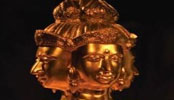
Mengrai: Arguably, and often-accepted as,
the best Thai restaurant in Toronto, Mengrai
also proves to be one of the more convivial
dining experiences in a city well-known for
unassuming style, thanks in no small part to
the charms of owner Allan Lim. Toronto's own
Mr. Chow creates an ebullient atmosphere,
complete with table-hopping and genuine
enthusiasm at the arrival of each new party,
until nearly everyone in the lovely, low-lit
room appears to know one another. Winner of
numerous awards from Bon Appetit, Tourism
Toronto, and Fodors, Chef Sasi Meechai-Lim
(wife of Allan) achieved critical acclaim at
Me Thai, Mengrai's previous incarnation -
and was the the first female chef from
Canada and Thailand to participate in an
Iron Chef event. Located in a former
brewery, complete with dumbwaiter, exposed
brick walls, and dark wood floors in a
neighborhood known as Corktown for its
proximity to the Distillery District,
Mengrai is but a few blocks south of the Gay
Village - and well worth the walk for its
superb and authentic Thai cuisine, such as a
sublime Bangkok "street style" pad Thai, and
the justifiably famous #54 (the number on
the menu at Me Thai), a red curry with
lychee, infused with kaffir lime leaf and
coconut, and served inside a pineapple. Chef
Sasi's bold re-interpretation of traditional
Thai cuisine is the reason to dine here -
but we must mention that numerous Hollywood
celebrities seem to dine here as well,
making Mengrai the Toronto equivalent to
Dave in Paris. You'll want to be here too,
basking in Allan Lim's joie de vivre.
LINK:
http://www.mengraithai.com/
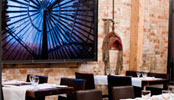
Archeo: The quieter half of Toronto's very
popular Boiler House, Archeo (a diminutive
of "archeology") is named for its location
within the Distillery District, a
neighborhood with a rich and multi-layered
history. Housed in a splendid example of
Victorian architecture, complete with high
yellow pine ceilings, exposed brick walls,
concrete floors, and a reclaimed timber bar,
the restaurant is a dazzling marriage of
industrialism and contemporary style. Artist
Steven Evans's splendid wall-sized
photographs of the building serve as movable
room dividers - and a reminder of what the
rooms were like when used by Victorian
carpenters and plumbers. At lunch, the room
is an oasis, a sanctuary of hushed voices
and agreeable servers - and a menu
emphasizing seasonal cuisine and comfort
food. Panzanella is a toothy melange of
stewed cherry tomatoes and crusty bread,
while the pizzas are as crispy as those in
Napoli. A cookie plate for dessert includes
mocha meringues, almond biscotti, and
oatmeal raisin and proves a perfect
complement to the delicious espresso. An
Italian sanctuary in the Victorian
Distillery District.
LINK:
http://www.archeo.ca/
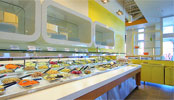
Commensal: The Toronto outpost of this
well-loved, seven-franchise chain of
vegetarian restaurants located throughout
Canada is situated in the heart of Toronto's
business district, a mere few blocks from
the Gay Village. Completely renovated in
2006, Commensal Toronto offers a self-serve,
buffet experience, roughly the equivalent of
an endless brunch - albeit with entirely
vegetarian and vegan options, including an
array of over 100 hot and cold options, as
well as scrumptious desserts. For nearly two
decades, Commensal Toronto has been feeding
omnivores, as well as herbivores because
their healthy recipes are nearly impossible
to resist - a fact which owner Susanna Yeung
asserts when she states that many of her
customers are not vegetarian. This clean and
well-lit restaurant also serves breakfast to
many of the well-heeled businessmen in the
neighborhood (we're just saying...).
Commensal’s commitment to their patrons’
(and the planet’s) health have earned the
restaurant a nomination for the Phenix de
l’environnement Award 2010. Want to feel
good after eating? Eat here. As Commensal’s
motto has it: "Taste Life."
LINK:
http://www.commensal.com/en/ou/restaurants/toronto/default.idigit
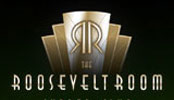
Roosevelt Room: Hollywood's Roosevelt Hotel
is the inspiration for this supper
club/lounge, which also serves dinner in an
anteroom off the dance floor. Multiple
wall-mounted television screens play old
movies (silent screen siren Louise Brooks in
Pabst's "Lulu" the night we were there) and
some of the wait staff and bartenders look
as if they might be extras in yet another
filmed version of The Great Gatsby.
LINK:
http://www.therooseveltroom.ca/
TORONTO WINTER CALENDAR:

Prism Presents Massive
Friday, 10 December 2010
For the first time in ten years, the
Guvernment's Main Room will become home for
Toronto boys and their international friends
for the grand opening of Massive. Called
Revival, Holiday Edition, and featuring the
sounds of DJ Hector Fonseca, DJ Honey Dijon,
with massive sound, massive lights, and
massive men, this party is certain to
be...massive.
LINK:
http://www.prismtoronto.com/
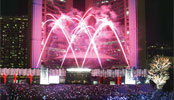
Cavalcade of Lights
27 Nov - 31 December 2010
Created in 1967 to showcase Toronto's new
City Hall, this year's 44th edition of
Toronto's Cavalcade of Lights kicks off with
the lighting of the tree on the 27th of
November, followed by fireworks and a
skating party.
LINK:
http://www.toronto.ca/special_events/cavalcade_lights/2010/

Toronto Christmas Market
3 - 12 December 2010
Christmas markets originated in the 15th
century in Germany, marked by the sights,
scents, and sounds of the holiday season -
and Toronto's version occurs in the
Victorian-era Distillery District, complete
with street markets, stage performances,
carolers and choirs, as well as Rudolph's
Reindeer Zoo.
LINK:
http://www.torontochristmasmarket.com/

Interior Design Show
27-30 January 2011
Canada's largest contemporary design fair
celebrates its 13th edition with more than
300 exhibitors, including designers and
studios, showing unique products and
installations to help re-ignite your
imagination in thinking about redesigning
your personal and professional spaces.
LINK:
http://www.interiordesignshow.com/

Toronto Winter City Festival / Winterlicious
28 Jan - 10 Feb 2011
Toronto's citywide celebration of all things
culinary, Winterlicious enables Torontonians
and visitors to indulge in mouth-watering
meals at prix fixe promotional rates.
LINK:
http://www.toronto.ca/special_events//winterlicious_event.htm
GETTING THERE / OUT AND ABOUT:
Bruce Bell Tours: Named the Official
Historian of St. Lawrence Market (one of
Toronto's more capacious and bountiful food
halls) by the city of Toronto, Bruce Bell
offers walking tours into some of Toronto's
more distinctive and character-rich
neighborhoods, while entertaining his guests
with his dry wit and his archival knowledge
of Toronto's colorful history.
LINK:
http://www.brucebelltours.ca/
Air Canada: Toronto's Pearson International
Airport has more daily flights into the US
than any other airport in the world; more
than 350 flights arrive daily from the US,
and more than half of the US population is
within a 90-minute flight to Toronto. In
other words: Toronto's a breeze to get to by
air; from NYC, it's about an hour.
LINK:
http://www.aircanada.com/en/home.html
Amtrak: Travel to Toronto on the Maple Leaf,
a twelve-hour pictorial train ride through
the Hudson River Valley, New York's wine
country, the Finger Lakes region - and on to
the spectacular vistas of Niagara Falls. The
perfect journey for reading Tolstoy's Anna
Karenina.
LINK:
http://www.amtrak.com/
|